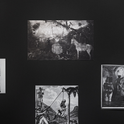Fashion is gloriously pleasurable to describe but fiendishly difficult to analyse. It is a cultural phenomenon that tugs in two directions—on the one hand, we (and to a greater or lesser extent almost everyone is subject to its demands) desire the approval of the group; on the other, we want our clothing choices to express the ineffable specialness of us, and how we wish others to see us. Fashion embodies the contradiction between conformism and individuality.
Historian Peter K Andersson has personal experience of this paradox. As a teenager, when his contemporaries were either goths or in trackies, Andersson favoured tweed jackets, bowties and the carrying of umbrellas. He stuck out in 1990s provincial Sweden, but, as he explains here, he was conforming to a sartorial impulse that placed him in a long historical tradition. The young Andersson was, in fact, a dandy, configurations of which have popped up all over the world since Beau Brummell wore his awesomely elaborate ruffled ascot neckwear.
In this entertaining history of the dandy, Andersson looks at manifestations of dandyism, from Brummell’s Regency to the modern hipster. Men’s fashions didn’t start with Brummell (far from it), but Andersson sees dandyism, as we understand it today, as developing from one particular form of masculine garb: the suit. So it starts with the essential—trousers, jacket, tie (or neckwear of some description)—and then has fun with them. Dandies revere the suit but also send it up; it’s a way of cultivating middle-classness at the same time as kicking it. Coloured socks and waistcoats, flashy watch chains, loud checks, tie knots—big, small, complicated—and all manner of interesting scents, accessories and poses. These are the dandies’ arsenal for public performance. “Mischievous provocations at the current dominant ideals of masculinity,” is how Andersson puts it. It is also of course about class, because dandyism is, at its heart, a plebeian fashion movement: it takes the core elements of gentlemanly apparel and refashions them in myriad ways for a variety of urban subcultures.
Brummell, Andersson’s progenitor of dandyism, was not plebeian (he was a close friend of the Prince Regent), but his celebrity, spread by pamphlets, newspapers and pictures, gave him Regency street appeal. So Brummell’s style percolated outwards into sections of society he would never himself have encountered, propelled, as the 19th century went on, by cheaper imported fabric and off-the-peg clothing. Brummell was not a flashy dresser, though he was an exquisite one—so much so that it took him five hours to get dressed every day. His cloth was beautifully cut and his colours sombre. Brummell’s clothing in fact marks a distinct movement away from the popinjay festoonery of the 18th century, as exemplified by the androgynous “macaronis”. Andersson quotes the psychologist John Flügel on how Brummell’s dress marks the “great male renunciation” and the emergence of the new, patriarchal, disciplined, sombre-suited image of masculinity that took hold during the reign of Queen Victoria.
Dandies revere the suit but also send it up; it’s a way of cultivating middle-classness at the same time as kicking it
Andersson takes us through so many iterations of dandyism that it can be confusing to keep track of them. He divides the book, broadly, into 14 case studies, and concentrates mostly on Britain but occasionally drops in on similar or parallel movements in Europe or the United States and, at the end (and fascinatingly), Congo. Starting in 1818, he finds the word “dandy” used by an outraged press at the trial of a young man accused of throwing a stone at a window in Marylebone. The word became associated with a host of distasteful subversions. Aping one’s betters by copying the clothing of a gentleman was the worst, but there was also the taint of irredeemable unseriousness and personal vanity, or “foppery”—Anne Brontë made the foppish wearing of corset-like stays the hallmark of a character’s villainy. Dandyism was viewed by the public with hostility (a series of Cruikshank cartoons called dandies “monstrosities”) as being effeminate and therefore worryingly French. But (another dandy contradiction) it was nonetheless also associated with a new and sinister brand of alpha masculinity: the kind that consciously adopts unmasculine traits in order to philander. The perfumed and pomaded “masher” who pranced about the stage door of music halls in the mid- to late-19th century was a byword for a seducer of gaiety girls.
It’s hard to keep up with the dandies as they parade through the 19th century. Before the mashers were the bucks and blades, then the swells and gents and snobs and counter-jumpers. They were mostly young clerks, part of the expanding white-collar lower-middle class in gentlemen’s outfitters departments (Andersson thinks this may be the origin of the “gent”). They wore their trousers checked and as baggy as pantaloons, and favoured lots of rings and pouffed-up hair, buttonholes and diamond pins. Group membership was conveyed by sucking their canes (this was a thing) and, later in the century, by affecting upper-class phrases such as “don’t you know” or “deuced queer”. In post-abolition, racially segregated New York, the Tenderloin district became the centre of the black dandies, young men who dressed with extravagant care and flamboyance and, in a further sub-category, the “dudes”, who favoured the restrained “English gentleman” look.
In the 1920s, the “knuts” adopted monocles, a fad that was in turn co-opted by cross-dressing lesbians. Andersson in fact wonders whether the popular adoption of the men’s suit by lesbians led to its eventual deconstruction in the late 20th century. But that is some way down the line because we have diversions into Paris and Stockholm and Vienna, and the “gigerls” and the “grilljannars”, and then, in the 1940s, the zoots, with their zoot suits (super-padded shoulders and wide lapels) and fedoras, which proved to be a long-lived branch of dandyism and international in reach. The look emerged from a swing music subculture but soon overlapped with a street gang one. In the US, zoots were derided as draft-dodgers; and in Germany, known as Schlurfs, they presented themselves as the slouching, insouciant opposite to the Hitler Youth.
In late-20th-century Congo, the sapeurs sported brightly coloured suits and twirled the dandy’s ubiquitous cane
After the war, we are rushed through teds and mods and the “peacock revolution” of Carnaby Street via an intriguing diversion into late-20th-century Congo, where in the capital, Brazzaville, the sapeurs sported brightly coloured suits and spotted handkerchiefs and twirled the dandy’s ubiquitous cane. Andersson wonders if the sapeurs were Congolese students studying existentialism in Paris who had brought home with them a “spirit of freedom, excess and conquest”.
We end up (rather exhausted), after a short pause with the new romantics, at the doorstep of hipsterism, which Andersson thinks may be the best example yet of the way that dandyism allies itself with both a rebel subculture and the mainstream. Perhaps it is dandyism’s final throw.
Andersson has ploughed through the press coverage of two centuries to bring us a host of examples. There is colour and description and intriguing detail, from numerous primary and secondary sources. But (as the author himself regularly reminds us) dandyism, like the whims of fashionable taste, is not an easy idea to grab hold of, let alone subject to close analysis. The book could have done with a tighter edit, and the background history seems often so broad brush as to mist over completely. But the reader is left with the pleasurable sensation of having enjoyed some stylish company.












